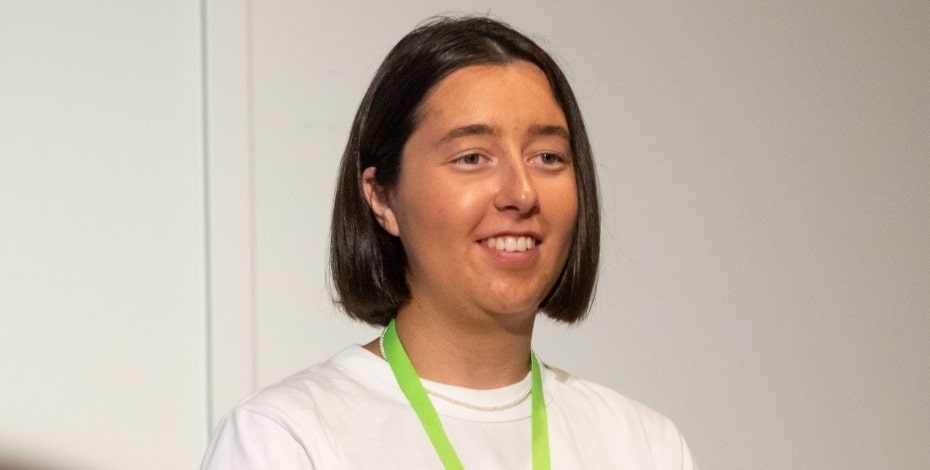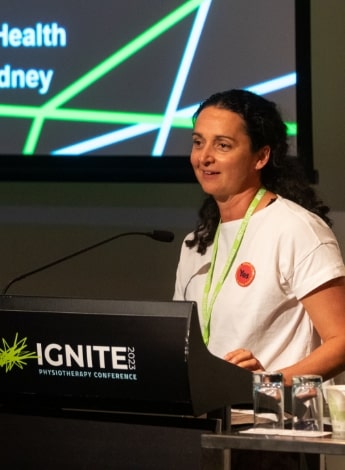
Culturally appropriate arthritis education resources for Aboriginal people

The first culturally appropriate education resources for Aboriginal and Torres Strait Islander people with arthritis have been developed, in a process based on community engagement and a co-design approach. Researcher Brooke Conley talks about the Staying Moving, Staying Strong project.
Arthritis conditions, including osteoarthritis, rheumatoid arthritis, lupus and gout, are common among Aboriginal and Torres Strait Islander people, affecting about 85,600 people or more than 10 per cent of the Aboriginal and Torres Strait Islander population.
Arthritis conditions have a huge impact on all aspects of a person’s health and wellbeing, affecting their ability to perform daily, social and cultural activities.
A key aspect of arthritis management is education, including education on the disease itself and on treatment and self-management options.
‘Education is integral to arthritis management and when it aligns with the information needs and preferences of individuals, it can help to increase disease knowledge and to change attitudes, beliefs and behaviours, ultimately facilitating self- management,’ says Brooke Conley APAM, a physiotherapist and PhD student at the University of Melbourne.
Until recently, there have been no education resources that have been designed to meet the needs and preferences of Aboriginal and Torres Strait Islander people living with arthritis conditions.
Brooke, a proud Ngiyampaa woman from Cobar, New South Wales, is part of a national interprofessional team of Aboriginal and non-Aboriginal health professionals and research leaders who are undertaking translational research to improve care for Aboriginal and Torres Strait Islander people with arthritis conditions.
The team includes other Aboriginal researchers—Gumbaynngirr woman Jane Linton; Badimaya, Wajarri, Wilunyu woman Charmaine Green; Ngoonooru Wajarri woman Wanda Flanagan; Whadjuk, Balladong, Gnarla Karla Boodja Nyoongar man Trevor Pickett; and Noongar (Wardandi) man Jonathan Bullen—and Aboriginal people with lived experience of arthritis conditions in the form of two community reference groups.
The remaining team members include non-Aboriginal researchers with experience in Aboriginal and Torres Strait Islander health and/or musculoskeletal pain research including arthritis (Ivan Lin, Samantha Bunzli, Penny O’Brien and Jennifer Persaud).
One recent project the team has been working on (Staying Moving, Staying Strong) aimed to create and deliver culturally appropriate arthritis resources that were informed by and incorporated the cultural rights, values, beliefs, knowledge systems and expectations of Aboriginal and Torres Strait Islander people.
This project was supported by several organisations, including Arthritis Australia and Arthritis and Osteoporosis Western Australia, as well as by the Australian Government.
Their research project brought together educational recommendations from clinical practice guidelines and the educational needs and priorities of Aboriginal people with arthritis conditions, which were explored in research yarns.
A research paper focusing on this is currently under review for publication and is expected to be published later this year.
In a separate arm of the study, Brooke has also recently published a series of systemic reviews of clinical practice guidelines for osteoarthritis, rheumatoid arthritis and gout, identifying and defining the core recommendations for each arthritis condition.
The team worked with 30 Aboriginal people with arthritis conditions in both Victoria and Western Australia, using research yarning as a way to engage participants in their health stories.
Research yarning, developed by Aboriginal researcher Professor Dawn Bessarab, is a method of collecting qualitative data through a conversational interview or yarn.
‘It’s less structured and more about the conversation.
‘It’s very fluid and open to wherever the conversation goes with that individual person and their story,’ says Brooke.
In all, 13 recommendations for education resources, including suggested content and delivery, were generated after analysis of the yarns.

Jane Linton speaking at the APA's IGNITE 2023 national physiotherapy conference.
The data and recommendations were discussed in a session presented by Brooke and colleagues Jane Linton and Dr Penny O’Brien at the recent IGNITE 2023 national conference.
Content recommendations included the impact of arthritis on health and wellbeing; when/how to access care; management options, including the benefits and risks of different options; and disease knowledge, including prognosis and addressing unhelpful beliefs.
Participants noted that they wanted to know not just what to do to manage the condition but how and why it would help.
They also expressed a desire for education that recognised Aboriginal culture, including bush medicine.
The recommendations also identified that education resources should be jargon-free, include positive stories of lived experience, flags and colourful local art and be delivered by health professionals, family and/or Aboriginal community members in the form of brochures, videos and/or yarning circles.
As one of the participants, a Yorta Yorta woman from Victoria, said in a quote discussed by Jane Linton in her
presentation at the conference,
‘Having other people—having others—others around you know and what their journey is, that’s really important.
‘And also putting it in a journey conversation that’s relatable to other Aboriginal people.
‘With the kids listening to Aboriginal voices and knowledges, learning from community for community and going on a journey to learn ways that have meaning for mob.’
From this research project, a series of education resources—including four brochures and six videos showcasing the lived experience of Aboriginal people with osteoarthritis, rheumatoid arthritis, lupus and gout—have been created.
These education resources were released late in 2023 via the Arthritis Australia and Arthritis and Osteoporosis Western Australia websites and will be further disseminated through Aboriginal Community Controlled Health Organisations and Aboriginal Medical Services across Australia.
A dedicated website to house these education resources is currently in development.
The education resources were developed in a co-design process with a community reference group of Aboriginal and Torres Strait Islander people in Victoria and Western Australia who experience arthritis.
‘We reviewed it with a wider group than just our project team—with our community reference groups and other people with whom we’ve connected along the way.
‘We reviewed the language used in the brochures and the content was guided heavily by the interview data so there are references to, for example, bush medicines and Aboriginal health service links around Australia,’ Brooke says.
The team plans to evaluate the impact of the brochures and videos as a resource for Aboriginal and Torres Strait Islander peoples and communities across Australia.
It’s an important part of the process, says Brooke, noting that the resources were developed based on feedback from a small group of Aboriginal people.
For Brooke, the project, which is the backbone of her soon-to-be-completed PhD, has allowed her to bring together her twin interests in musculoskeletal conditions and in Aboriginal and Torres Strait Islander health.
‘I definitely knew that if I wanted to do anything in the research space, it would be a crossover between those two topics,’ she says.
>> Visit stayingstrongwitharthritis.org.au to access the brochures and videos.
© Copyright 2024 by Australian Physiotherapy Association. All rights reserved.





